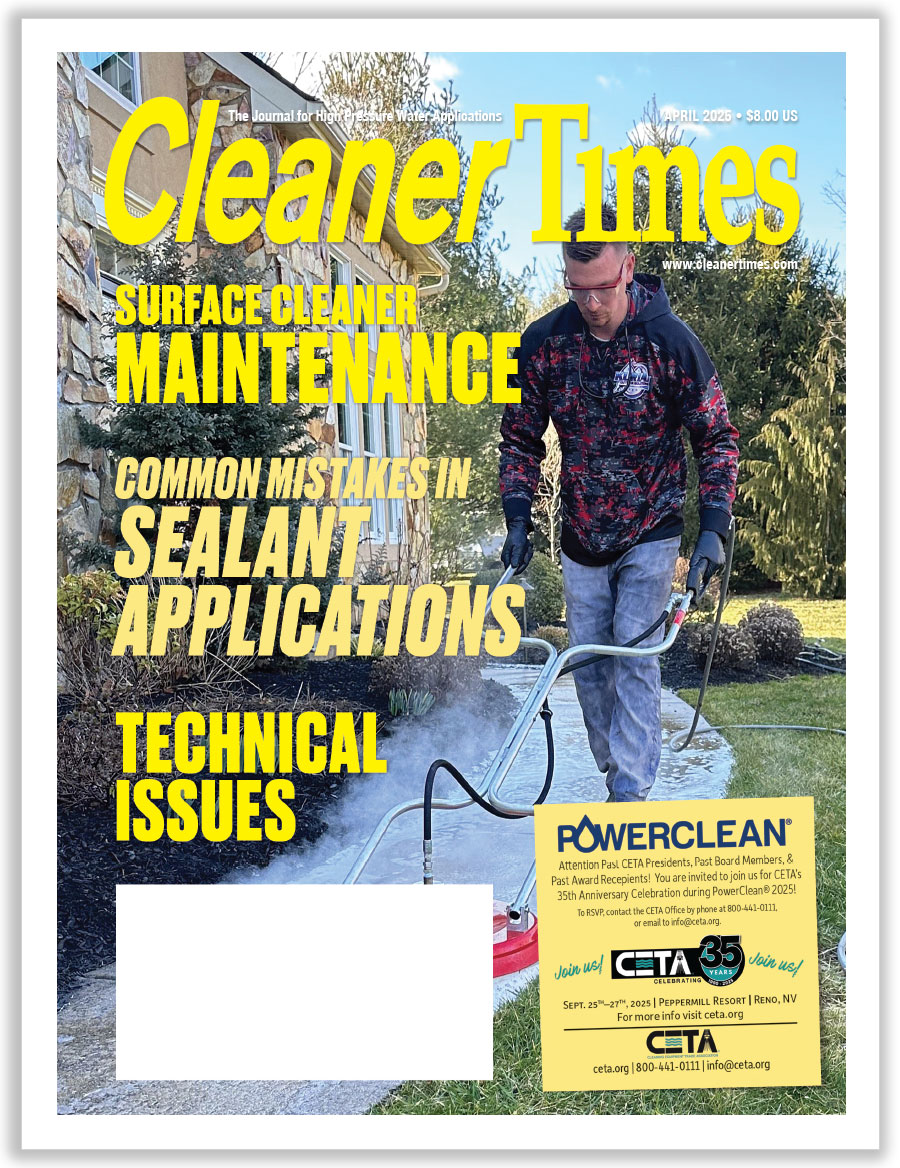
Financial: Partnering in Tax Savings
By Mark E. Battersby / Published April 2015

Whether it is two individuals working to run a more profitable enterprise or a pressure washing business in a joint venture with others, partnerships are an increasingly popular business entity. In fact, partnerships rank just behind S corporations as the most common type of business entity. Unfortunately, although an entity isn’t usually required to pay taxes, the tax rules reporting requirements and complexity have led many to go astray.
The basic concept of a partnership is that all profits and losses flow through to the partners, who are then responsible for taxes. In essence, partnerships are unincorporated businesses or joint ventures with two or more partners. Because partnerships are unincorporated, the IRS does not tax them directly. Instead, profits that flow to the partners are taxed as their income.
Although a partnership does not pay taxes on its profits, it must report its operating losses or profits to the IRS on Form 1065, U.S. Return of Partnership Income. The partnership must also send Schedule K-1 to partners alerting each to their share of profits or losses, with these amounts reported on the partners’ income tax returns.
Typecasting Partnerships
There are three general types of partnership arrangements:
1. General Partnerships, where profits, liability, and management duties are divided equally among all partners. If an unequal distribution is made, the percentages assigned to each partner must be documented in the partnership agreement.
2. Limited Partnerships (also known as a partnership with limited liability), allow partners to have limited liability as well as limited input in management decisions. These limits depend on the extent of each partner’s investment percentage. Although more complex than general partnerships, limited partnerships are attractive to investors in short-term projects.
3. Joint Ventures are usually classed as general partnerships, but for only a limited period of time or for a single project. Partners in a joint venture can be recognized as an ongoing partnership if they continue the venture, but they must file as such.
Partnership Taxes
A pressure cleaning business partnership must register with the IRS as well as with state and local revenue agencies and obtain a tax ID number or permit. Once formed, a partnership “passes through” any profits or losses to its partners.
Whether or not each partner actually receives the amount stated on the Schedule K-1 filed by a partnership is irrelevant. The IRS levies taxes based on a partner’s “distributive share,” which is the percentage of the pressure washing operation’s profits the partner is entitled to. If, for example, the partnership agreement states, or the partners simply agree, that a certain percentage of profits should stay within the partnership (e.g., to pay for expansion or overhead), this doesn’t matter to the IRS. Their focus is on what each partner’s share ought to be. Otherwise, partnerships could retain profits to avoid paying taxes.
The distributive share of each partner is usually determined by the partnership agreement. In the absence of a written partnership agreement, profits are usually split evenly. Should, for example, the partnership agreement for a pressure cleaning business state that one partner will receive 70 percent of the profits an losses, with another partner allocated the remaining 30 percent, then that 70/30 split will represent each distributive share. Without a written agreement—or no special allocation—each distributive share is automatically 50 percent of profits and losses.
Special Allocations
It is only when a partnership has made a Code Section 754 election, a so-called “special allocation,” that the tax rules allow adjustments to be made. In general, a 754 election permits adjustments to a partner’s share of the tax basis of the partnership assets, referred to as the “inside basis,” so that it is equal to the tax basis of the partner’s partnership interest, referred to as the “outside basis.” If no 754 election has been made, no adjustments can be made to the inside basis of partnership assets unless mandatory adjustments are required by the IRS.
Other Partnership Taxes
Not too surprisingly, there are several tax issues partners must consider. Partners, for example, are considered to be self-employed, not employees, and therefore need to file a Schedule SE with their Form 1040 and pay self-employment taxes.
Because of this self-employed status, each partner is also responsible for paying his or her share of Social Security taxes and Medicare. Partners are responsible for paying double of what a normal employee would pay (because employers normally match employees’ contributions). Of course, the partners’ tax burden is reduced by an allowance for one-half of the self-employment tax that can be deducted from taxable income.
Partnership Advantages
1. Easy and Inexpensive. Partnerships are generally an inexpensive and easily formed business structure.
2. Shared Financial Commitment. In a partnership, each partner is equally invested in the success of the pressure cleaning business. Partnerships have the advantage of pooling resources to obtain capital, often beneficial when seeking credit.
3. Complementary Skills. A good partnership will usually benefit by utilizing the strengths, resources, and expertise of each partner.
4. Partnership Incentives for Employees. Offering employees the opportunity to become a partner can be an advantage in attracting highly motivated and qualified employees to any pressure cleaning business.
Disadvantages of a Partnership
1. Joint and Individual Liability. Partners are not only liable for their own actions, but also for the business debts and decisions made by other partners. What’s more, the personal assets of all partners can be used to satisfy partnership debt.
2. Disagreements Among Partners. With multiple partners, disagreements are common. Partners should consult each other on all decisions, make compromises, and resolve disputes as amicably as possible.
3. Shared Profits. Because partnerships are jointly owned, each partner must share the successes and profits of the pressure cleaning business with the other partners. An unequal contribution of time, effort, or resources often results in discord among partners.
Limited Liability Partnerships
A limited liability partnership, or LLP, is a fairly new entity for operating a pressure washing business that provides increased liability protection for partners. Technically, an LLP is not a different business structure than a standard partnership. In other words, an LLP can be a general or limited partnership and is treated similarly for tax purposes.
An LLP extends the liability protection of a limited partner to that of a general partner. Typically a general partner in an LLP is not liable for debts and obligations stemming from errors, negligence, or misconduct committed by another partner, employee, or agents of the pressure cleaning business unless the general partner had knowledge of it. A general partner is, however, still liable for other partnership debts as well as for his or her own actions.
Despite the similarity in name, an LLP is not a limited liability company (LLC). A general or limited partnership needs to register with the state, but the registration does not change the business entity of the partnership. An LLP does not have the structure of an LLC, and does not have the tax flexibility that an LLC enjoys of choosing how to be taxed as either a partnership or a corporation. That choice can offer tax advantages to an LLC depending on the pressure cleaning business’s specific situation. An LLP, however, can only be taxed as a partnership.
Passive Loss
As mentioned, a partnership must file an annual information return to report its income and losses even though it does not pay income tax. Instead, it “passes through” any profits or losses to its partners with each partner showing such profits or losses on their personal income tax returns. Loss deductions can be claimed—but only for amounts that do not exceed the book value of their investment in the pressure washing business. Losses where the partner is more of an “investor” are another story.
A passive loss is defined as a loss resulting from an investment in a business in which the investor does not “materially participate.” To be considered a non material participant, the investor cannot be continuously and substantially active or involved in the business activity.
Passive losses can only be written off or used to offset passive gains. When losses exceed the income from passive activities, the remaining loss can be carried forward to the next tax year, provided there is some passive income to write it off against.
Reporting Requirements
It should be kept in mind that even though a pressure cleaning business partnership has no assets, no bank account, no income or expenses and may, in fact, be dormant, a tax return must be filed. Penalties can be assessed based on the number of K-1s and the number of months a Form 1065 is late.
Fortunately, the income of every partnership decreases with every dollar spent on legitimate business expenses. Expenses are often a large portion of revenue and will reduce taxable income (and therefore, each partner’s tax bill) by a significant amount. Naturally, professional assistance may be required to take full advantage of a pressure cleaning business partnership or joint venture—and to avoid the many potential pitfalls.




